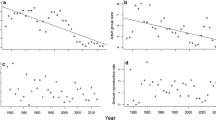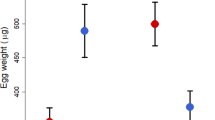Abstract
COOPERATIVE breeding, which often involves young remaining on their natal territory and helping their parents to raise subsequent broods1–3 is mostly explained by habitat saturation: young are constrained from becoming independent breeders by a shortage of breeding territories2,4. Here I present two lines of evidence against this hypothesis for the cooperatively breeding Seychelles warbler Acrocephalus sechellensis. first, territory quality has a significant effect on dispersal: vacancies arising on territories are mostly filled by prebreeding birds from territories of the same or lower quality. Second, individuals that delay reproduction in high-quality territories, but which eventually breed there, have greater lifetime fitness than those that disperse at one year of age and breed immediately in lower-quality territories. These results support the 'benefits of philopatry,5,6 hypothesis, which emphasizes the lifetime inclusive fitness benefits from staying at home. The transfers of warblers to unoccupied islands was the strictest experimental test of this hypothesis. At first there was no cooperative breeding, but as all high-quality areas became occupied, young birds born on high-quality territories began to stay as helpers, rather than occupying breeding vacancies on low-quality territories. Therefore habitat saturation and territory quality are both involved in the evolution of cooperative breeding.
Similar content being viewed by others
References
Woolfenden, G. E. & Fitzpatrick, J. W. The Florida Scrub Jay: Demography of a Cooperative Breeding Bird (Princeton University Press, New Jersey, 1984).
Brown, J. L. Helping and Communal Breeding in Birds (Princeton University Press, New Jersey, 1987).
Emlen, S. T. Evolution of Cooperative Breeding in Birds and Mammals. Behavioural Ecology: an Evolutionary Approach (ed. Krebs, J. R. and Davies, N. B.) 301–337 (Blackwell Scientific, Oxford, 1991).
Selander, R. K. Univ. Calif. Pub. Zool. 74, 1–224 (1964).
Stacey, P. B. & Ligon, D. J. Am. Nat. 130, 654–676 (1987).
Stacey, P. B. & Ligon, D. J. Am. Nat. 137, 831–846 (1991).
Collar, N. J. & Stuart, S. N. Threatened Birds of Africa and Related Islands. The ICBP/IUCN Red Data Book (ICBP, Cambridge, UK, 1985).
Diamond, A. W. ICBP, Technical Publication 3, 239–251 (1985).
Diamond, A. W. Proc. IX Pan-African Ornithol. Congr. 253–266 (1980).
Brooke, M. de L. & Houston, D. C. J. Zool. Lond. 200, 779–795 (1983).
Komdeur, J. thesis, Univ. Cambridge, 1991).
Koenig, W. D. & Mumme, R. L. Population Ecology of the Cooperatively Breeding Acorn Woodpecker (Princeton University Press, New Jersey, 1987).
Komdeur, J., Bullock, I. D. & Rands, M. R. W. Bird Conservation International 1, 179–188 (1991).
Huffstadt, A. & Prast, W. E. thesis, Univ. Amsterdam (1992).
Koenig, W. D., Pitelka, F. A., Carmen, W. J., Mumme, R. L. & Stanback, M. T. Q. Rev. Biol. (in the press).
Author information
Authors and Affiliations
Rights and permissions
About this article
Cite this article
Komdeur, J. Importance of habitat saturation and territory quality for evolution of cooperative breeding in the Seychelles warbler. Nature 358, 493–495 (1992). https://doi.org/10.1038/358493a0
Received:
Accepted:
Issue Date:
DOI: https://doi.org/10.1038/358493a0
- Springer Nature Limited
This article is cited by
-
Unveiling juvenile dispersal distances in the rufous hornero: observational notes
Ornithology Research (2024)
-
Immunogenetic variation shapes the gut microbiome in a natural vertebrate population
Microbiome (2022)
-
Assessing the causes and consequences of gut mycobiome variation in a wild population of the Seychelles warbler
Microbiome (2022)
-
Cooperation by necessity: condition- and density-dependent reproductive tactics of female house mice
Communications Biology (2022)
-
Resources and predation: drivers of sociality in a cyclic mesopredator
Oecologia (2022)





